

Education on Air: Keynote. The Nuts and Bolts of Explicit Modeling. Although many other methods of teaching are noteworthy -- such as case study, problem-based learning, and simulation -- many scholars agree that students need "careful, personal instruction with clear demonstrations in reading and writing", as well as in social studies, math, and science.
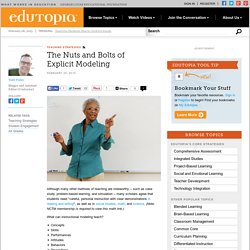
(Note: NCTM membership is required to view this math link.) What can instructional modeling teach? Teaching and Learning through Design Thinking - EdTech Researcher. Last week was a big week for design thinking in education, both in the field and for me personally.

In the wider world, Edutopia is hosting a free course on Design Thinking for Educators which launched last week and continues this week. For me, I facilitated a "Design Charrette" learning group at Project Zero's Future of Learning Institute. The Future of Learning Institute is a professional program run by the Harvard Graduate School of Education. It's a combination of plenary lectures, break-out group workshops, and then learning groups designed which are designed to foster discussion and reflection to synthesize learning. What Are the Most Powerful Uses of Tech for Learning? Student produce a web show with tablets (Brad Flickinger/Flickr) When we talk about the digital divide in education, the discussions revolve mainly around two factors: lack of access to the internet and lack of knowing how to use that access in powerful ways that can fuel learning beyond consuming content.
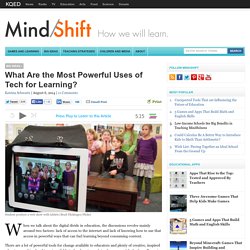
There are a lot of powerful tools for change available to educators and plenty of creative, inspired educators working hard to put available technology to work in classrooms. 5 Tips for Avoiding Teacher Burnout. I've read a lot of articles about preventing teacher burnout, so a new list is probably not that unique.
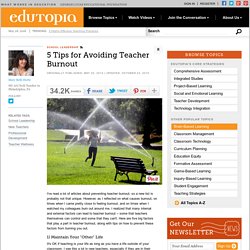
However, as I reflected on what causes burnout, on times when I came pretty close to feeling burnout, and on times when I watched my colleagues burn out around me, I realized that many internal and external factors can lead to teacher burnout -- some that teachers themselves can control and some that they can't. Here are five big factors that play a part in teacher burnout, along with tips on how to prevent these factors from burning you out. 1) Maintain Your "Other" Life It's OK if teaching is your life as long as you have a life outside of your classroom. I see this a lot in new teachers, especially if they are in their early 20s and just starting out. Digitalcommons.uri.edu/cgi/viewcontent.cgi?article=1103&context=jmle. LLiDAreportJune09.pdf. How to Infuse Digital Literacy Throughout the Curriculum.
So how are we doing on the push to teach “digital literacy” across the K12 school spectrum?

From my perspective as a school-based technology coach and history teacher, I’d say not as well as we might wish – in part because our traditional approach to curriculum and instruction wants to sort everything into its place. Digital literacy is defined as “the ability to effectively and critically navigate, evaluate, and create information using a range of digital technologies.” Many educational and business professional cite is as a critical 21st century skill. Even so, many schools have struggled to adapt it into their curriculum.
Futurelab - Resources Archive - Publications, reports & articles - VISION magazine - Let's get personal: what does personalised learnin. Most of us would like to think we've come a long way from the kinds of educational practices satirised by Dickens 150 years ago, which leave no scope at all for children's creativity, imagination or interests.
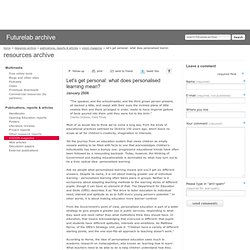
Yet the journey from an education system that views children as empty vessels waiting to be filled with facts to one that acknowledges children's individuality has been a bumpy one: progressive educational trends have often been followed by a resounding backlash. Today, however, the thinking of Government and leading educationalists is dominated by what may turn out to be a truly radical idea: personalised learning. Ask six people what personalised learning means and you'll get six different answers. Despite its name, it is not about making greater use of individual learning - personalised learning often takes place in groups. Toolset Skillset Mindset.pdf. 6 Scaffolding Strategies to Use With Your Students. What’s the opposite of scaffolding a lesson? Saying to students, “Read this nine-page science article, write a detailed essay on the topic it explores, and turn it in by Wednesday.”
Yikes! No safety net, no parachute—they’re just left to their own devices. Let’s start by agreeing that scaffolding a lesson and differentiating instruction are two different things. Scaffolding is breaking up the learning into chunks and providing a tool, or structure, with each chunk. Sites/default/files/ConnectedLearning_summary_0.pdf. Www.unity.net.au/padwheel/padwheelposterV3.pdf. Www.unity.net.au/padwheel/padwheelposterV3.pdf. Five Keys to Successful Social and Emotional Learning. Pamela Randall: Social-emotional skills are the essential skills for success in school, work and life.

Natalie Walchuk: Social-emotional learning centers their mind and body. It reduces their emotional tension, so they can be open to new content and material. We find that academic outcomes increase exponentially when students are nurtured, loved and cared for. That we get much more out of them when we first address social-emotional needs. So for us, it's actually an academic intervention, and not just an emotional one. Rigorous Project-Based Learning Transforms AP Courses. Studying With Quizzes Helps Make Sure the Material Sticks. iStock By Samara Freemark, American RadioWorks Roddy Roediger is a psychology professor at Washington University in St.

Louis and runs the school’s Memory Lab. He’s been obsessed with studying how and why people remember things for four decades. About 20 years ago, Roediger was running an experiment on how images help people remember. 7 Simple Ways You Can Help Students Pay Attention In A Traditional Classroom - 7 Simple Ways You Can Help Students Pay Attention by TeachThought Staff For many teachers, helping students “pay attention” is probably the wrong way to help improve what you’re probably trying to improve.

Listless students. The 33 Digital Skills Every 21st Century Teacher should Have. By EdTech Team Updated on march 2, 2015 : The original list that was created in 2011 comprised 33 skills , after reviewing it we decided to do some merging and finally ended up with the 20 skills below.
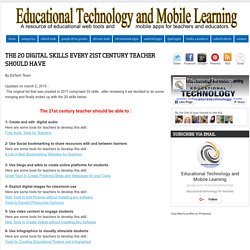
The 21st century teacher should be able to : 1- Create and edit digital audio Here are some tools for teachers to develop this skill :Free Audio Tools for Teachers 2- Use Social bookmarking to share resources with and between learners Here are some tools for teachers to develop this skill : A List of Best Bookmarking Websites for Teachers. Our technology messages are important When we take away technology access because of student behavior concerns, we send the message that digital devices and the Internet are optional, ‘nice to have’ components of schooling rather than core elements of modern-day learning and teaching.
When we ban teachers from using social media – but not other forms of interaction – to communicate with students in or out of school, we send the message that we are unable to distinguish between behaviors and the mediums in which they occur. When we decline to devote adequate time or support for technology-related professional learning and implementation, we send the message that low-level or nonexistent usage is just fine. When we require educators to go hat in hand to IT personnel to get an educational resource unblocked, we send the message that we distrust them so they must be monitored. When we make blanket technology policies that punish the vast majority for the actions of a few, we send the messages of inconsistency and unfairness. On-the-Spot Scaffolding for Students. Scrambling in the moment to figure out what students need when they just don't get it is one of the exciting challenges of teaching.
Being able to respond to learners' needs on the spot is hands down one of the greatest tricks of this trade. And when lesson planning, we can't always guess how many steps we will need to break a lesson into and how much support will be needed for each chunk. I know I've made assumptions about what students will "get" and then in the middle of the lesson, I've had to stop, think on my feet, and add something to help move the learning forward.
Just to be clear: Scaffolding a lesson and differentiating instruction are two different things. Scaffolding is breaking up the learning into chunks and then providing a tool, or structure, with each chunk. What Would a ‘Slow Education Movement’ Look Like? Big Ideas Shelley Wright/PLPNetwork The many incredible innovations of the 20th century have sped up the pace of life in addition to giving many people more access to information and communication tools. The anytime/anywhere learning made possible by mobile technology and the internet hold great potential for new ways of teaching, but some educators worry that the emphasis on efficiency and instant access is having a negative impact on some of the core tenets of education. In her Powerful Learning Practice Network article educator Shelley Wright advocates for a “slow education” movement that takes time to value human connection, curiosity and a love of learning. Ready to Learn? The Key Is Listening With Intention.
Teaching Strategies WoodleyWonderWorks Listening and observing can be passive activities—in one ear and out the other, as our mothers used to say. Report Finds ‘Deeper Learning’ Model Improves Outcomes for All Students. Failing forward, in technology and in life. Just another WordPress.com site. The Reflective Teacher: Taking a Long Look. Five Ways to Bring Innovation Into the Classroom. Can Student-Driven Learning Happen Under Common Core? What Can Educators Learn from the Gaming Industry? Harnessing Children’s Natural Ways of Learning.